- Home
-
About
 Fidelity & Excellence
Fidelity & ExcellenceThomas Aquinas College is unique among American colleges and universities, offering a faithfully Catholic education comprised entirely of the Great Books and classroom discussions.
-
A Liberating Education
 Truth Matters
Truth MattersTruth, and nothing less, sets men free; and because truth is both natural and supernatural, the College’s curriculum aims at both natural and divine wisdom.
-
A Catholic Life
 Under the Light of Faith
Under the Light of FaithThe intellectual tradition and moral teachings of the Catholic Church infuse the whole life of Thomas Aquinas College, illuminating the curriculum and the community alike.
-
Admission & Aid
 Is TAC Right for You?
Is TAC Right for You?Do you enjoy grappling with complex questions? Are you willing to engage in discussions about difficult concepts, with the truth as your ultimate goal?
-
Students & Parents
 Mind, Body & Spirit
Mind, Body & SpiritThere is always something to do at TAC — something worthwhile, something fulfilling, and something geared toward ever-greater spiritual and intellectual growth.
-
Alumni & Careers
 What Can You Do with a Liberal Education?
What Can You Do with a Liberal Education?Nothing speaks more to the versatility of the College’s academic program than the good that our alumni are doing throughout the Church and the world.
- Search
- Giving
Lecture: Dr. David Appleby on Monuments and Memory
Receive TAC lectures and talks via podcast!
“Monuments and Memory, Made and Unmade.”
by Dr. David Appleby
Tutor
St. Vincent de Paul Lecture & Concert Series,
Thomas Aquinas College, California
January 12, 2024
This evening I wish to say something about how monuments contribute to the making of memory, and how the unmaking of monuments also relates to memory formation. Certain patterns of remembering and forgetting present themselves when monuments are built, modified, repurposed, or damaged. Two apparent paradoxes emerge from this inquiry, first that some kinds of forgetting make their objects more memorable; and second that commemoration has more to do with the future than it does with the past. To illustrate these patterns and explain these apparent paradoxes, we will take a highly selective tour of some of the great (and a few of the not so great) personalities, places, and events of Western history in antiquity, late antiquity, and the early Middle Ages; some but not all of which are mentioned by authors we read in the College’s program.
1. Monument and Memory
The connection between monument and memory is very old. The early 7th-century AD encyclopedist Isidore of Seville was restating a piece of ancient common knowledge when he explained that the very word monument is derived from the verb moneo/monere, meaning to admonish or remind. He said that a funerary monument admonishes the mind of the visitor to recall the deceased person.[1], just as the epitaph incised in the monument recalls his noteworthy deeds. [2] In the absence of a sepulcher, the dead are forgotten.
Isidore’s binary juxtaposition of present monument and remembrance, on one side, and on the other, absent monument and oblivion is unusually blunt and categorical. But many examples from the ancient world show that those who erected funeral monuments certainly intended to shape memory. Herodotus, for example, mentioned several burial mounds in his account of the aftermath of the Battle of Plataea in 479 BC, in which the Hellenic forces defeated the Persian army which King Xerxes had left in central Greece under the command of Mardonius. Herodotus reported (9.85) that each city of the Hellenic coalition left its own burial mound or sepulcher on the battlefield. These included the Spartans, the Tegeans, the Athenians, the Megarians, and the Phleisians. Writing perhaps a generation after the battle, Herodotus reported that he had learned that some of the other burial mounds still visible on the battlefield, including that of the Aeginetans, in fact contained no human remains and had been heaped up years after the event “by peoples who felt disgraced by their absence from the battle” (9.85) in order to make it seem to posterity that their cities had fought too.
While Isidore concentrated on funerary monuments, my interest is in literal (not figurative) monuments of any sort: physically imposing civic, political, military, or funerary edifices, which were often adorned with reliefs, statues, or images, and which usually included an inscription or incised writing that was meant to be seen and read by visitors; and which, incidentally, allows us to make some inferences about the viewer response that was anticipated by the makers of the monument-- or by those who later repurposed parts of the monument.[3]
2. Monument as Bearer of Historical Information
Tonight’s discussion is not a history of monuments, but an account of monuments viewed historically. So before considering particular monuments, I should say a bit about how the historian evaluates and uses monuments as bearers of information about the historical past.
Historians nowadays no longer practice a rhetorical craft aimed at persuasion and moral improvement, but a critical discipline intended to disclose what actually happened in the past.[4] They divide historical materials into Sources (Quellen), Remains (Überreste), and Monuments (Denkmäler).[5] While sources from the past reflect their authors’ intention to interpret and explain events, remains are left over objects that reflect no intention to interpret; they are per se silent survivors from the past. Monuments resemble yet are distinct from each of the other classes. On the one side, a monument such as Trajan’s Column in Rome does what Sources do by representing a narrative, in this case a visual narrative, of the two military campaigns (in AD 101-102 and AD 105-106) in which the Roman Emperor Trajan defeated the Dacians. The bas-relief and the column’s dedicatory inscription present a highly partisan interpretation of the recent Dacian wars, celebrating Trajan’s victory over the enemy as a triumph of order and Latin civilization over chaos and barbarity.[6] On the other side, the monument answers to the definition of a Remain by unintentionally bearing witness to the state of marble construction and bas-relief carving; military clothing, equipment, and techniques; and the historical outlook of members of the Roman imperial elite in the first decades of the second century AD. The monument inadvertently bears historical information in addition to the interpretation of events which its makers deliberately sought to convey.[7] Sources of the past are indispensable to the present researcher, but are also subject to critical reserve, because of their intentional, interested, and often partisan character. Remains, by contrast, because they are unintentional, disinterested, and non-partisan, enjoy a probatory superiority to Sources, but suffer the disadvantages of particularity, isolation, and disconnection from a story. Monuments exhibit a hybrid character that may make them particularly useful to the historian, depending upon the questions the historian has in view. Let me turn now to some monuments.
3. Monuments with Foreign Spolia
One way of gaining a monument is to take someone else’s. The public display of foreign treasure and trophies was apt to be an enactment of dominion over the vanquished in a manner that celebrated the victor and reminded his supporters that the war had been worthwhile. Such repurposing of older objects in later monuments always meant investing them with commemorative and symbolic meanings different from the ones their makers intended. The Romans were especially good at this.
In 212 BC, after the siege and capture of Syracuse during which the mathematician and engineer Archimedes was killed, the Roman general Marcellus returned home in triumph with rich spoils. He carried away statues of the gods and other works of craftmanship and adorned Rome “with beautiful objects that had all the charms of Grecian grace and symmetry.” (Plutarch, Marcellus, trans. Dryden, pp. 423-424) According to Plutarch, until that time, victorious commanders had seized money and valuables, but not “fine and exquisite rarities… nor graceful and elegant pieces of workmanship”. The old men of the senate disapproved this new practice because they thought that beautiful civic adornments would encourage Roman citizens to become “peaceful or refined spectators”, and because in their view the practice gave the impression that Rome now “celebrate[s] victories and lead[s] processions of triumph, not only over men, but also over the gods as captives”. A famous instance of publicly celebrating the downfall of a foreign god appears in the frieze from the Arch of Titus in Rome which shows the parading in Rome of the Menorah and sacred vessels plundered from the Temple in Jerusalem at the time of its destruction in 70 AD.
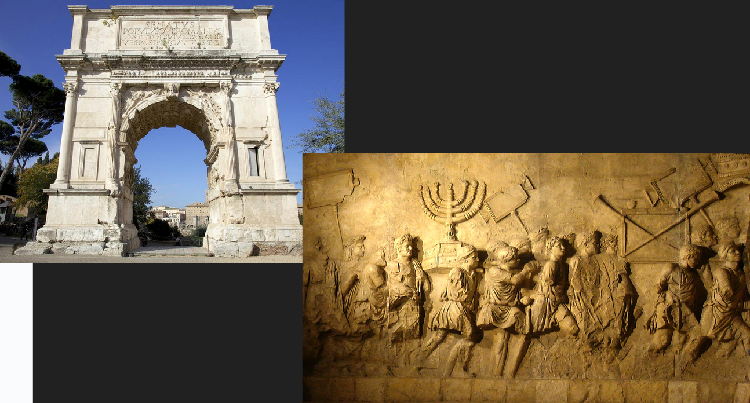
A taste for the ancient and exotic seems to have motivated the monument appropriation of some Roman emperors, who treated Egypt as a sort of cross between ANTIQUES ROAD SHOW and HOME DEPOT for DIY monument-builders. No fewer than eight ancient Egyptian obelisks were brought to the eternal city in antiquity.[8] The first two of these arrived in about 10 BC at the request of Octavian/Augustus who had taken Egypt by conquest after defeating Queen Cleopatra VII and Marc Antony in the Battle of Actium in 31 BC. In the lead-up to that war, the party of Augustus had vilified Cleopatra and sought to associate Marc Antony with her as a sort of would-be Xerxes. But this anti-Egyptian attitude swiftly changed after Actium, when Augustus formed the wealthy Ptolemaic kingdom into a Roman province with a garrison of three legions that were answerable to Augustus alone as proprietary governor. Some Egyptian astrological practices and the cult of the goddess Isis soon found their way to Rome, and Egyptian motifs such as sphinxes and pyramids began to appear in Roman coinage, wall decorations, and architecture. One obelisk Augustus placed in the Campus Martius and topped it with a gilt-bronze sphere and an inscription commemorating his conquest of Egypt. It had been quarried in Aswan during the mid-26th Dynasty (early 6th-century BC) and taken to Heliopolis where it was erected at the sanctuary of Re. This obelisk eventually fell over and was lost, and it was not excavated and restored until 1792 by Pope Pius VI, who placed it in Piazza Montecitorio where it is now. In its original context on Campus Martius, however, it functioned as the gnomon of a giant sundial which apparently cast a shadow pointing directly to the nearby Augustan Altar of Peace on the birthday of Augustus.[9] The second obelisk of Augustus was much older, dating from the 13th-century BC during the reigns of Pharaoh Seti I and his son and successor Ramses II. Both rulers are depicted on it as sphinxes offering a figure of the goddess of truth, Maat, to the sun god, Re. Like its travelling partner, this obelisk was capped with a gilt bronze sphere along with an identical inscription commemorating Augustus’ conquest. A Greek translation of the hieroglyphs doesn’t much resemble the original text, but several times mentions the god Apollo, who was Augustus’ patron. This obelisk Augustus placed in the Circus Maximus at the east end of the spina or long barrier down the center of the track. In these cases, it seems likely that the Romans knew the objects were old, but not how old, and that they were only able to guess at what the hieroglyphs meant.[10] What had been pharaonic votive offerings to the Sun god became exotic, mysterious, and physically imposing material elements in memorials that celebrated the power, success, and legitimacy of the political regime of Augustus.
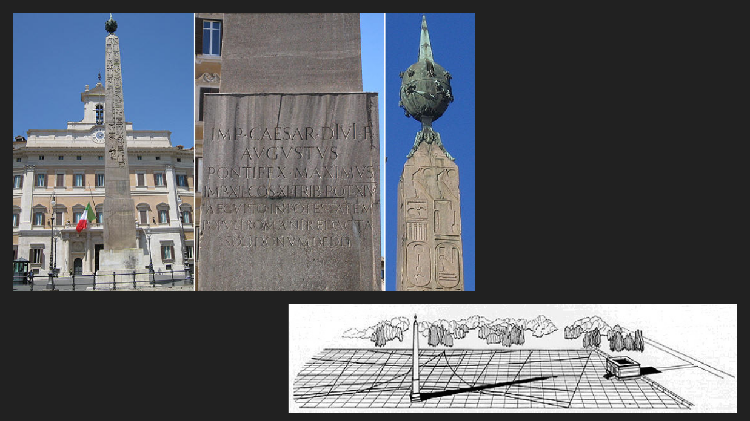
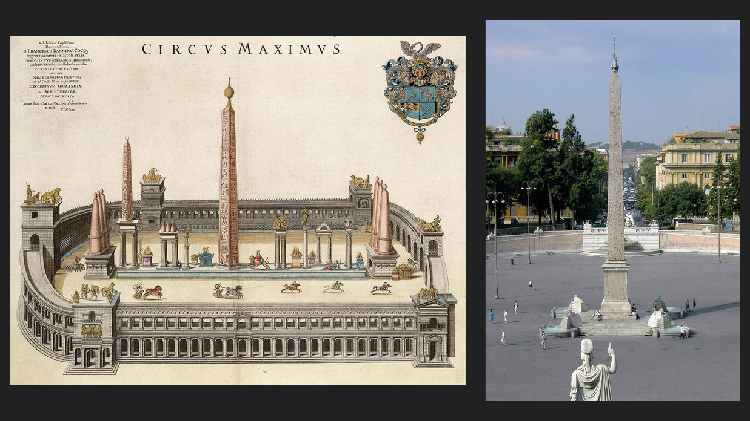
Even the leaders of peoples that Romans referred to as barbarians were sensitive to meanings conveyed by monuments and images; or, at any rate, it was plausible to think of them as being attuned to the “optics” of public images as a kind of embodied remembrance. In his History of the Decline and Fall of the Roman Empire, (parts of which we read in Junior Seminar) the 18th-century Edward Gibbon repeated an anecdote he found in a 10th-century Byzantine source regarding the infamous 5th-century enemy of Rome, Attila the Hun. After he captured the important north Italian city of Milan in 452 AD, in the royal palace Attila noticed a large image that showed Roman rulers sitting on golden thrones with the bodies of vanquished Scythian enemies at their feet. Attila summoned the painter, and ordered that he alter the picture to show Attila on the throne and Roman rulers pouring out bags of gold at his feet.[11]
4. Reuse with Positive Attitude to Original: Memory of Presence
It is only fair to acknowledge that the repurposing of older monuments was not always a way of displaying dominion or triumph. As readers of Plutarch’s Lives of the early Romans are aware, setting up statues and other public monuments as visual commemoration of generals, benefactors, and other elite figures was a characteristic feature of the culture of the Roman Republic.[12] In the Roman imperial period it was dangerous for a citizen to tamper with an image of the ruler. This was the case even in the early years of the empire, in the regime known as the Principate, when the ruler preferred to be addressed as the first citizen or the first man of the senate.[13] The idea that the respect or disrespect one shows to the image of the ruler passes to the ruler himself was explicitly affirmed in the more openly authoritarian environment of the later Roman Empire, both before and after the emperors became Christian.[14] In the early years of the 5th century, Bishop Severian of Gabala, preaching in Constantinople, made it clear that the emperor was virtually present in his publicly displayed images. He said that:
Since an emperor cannot be present to all persons, it is necessary to set up the statue of the emperor in law courts, market places, public assemblies, and theatres. In every place, in fact in which an official acts, the imperial effigy must be present, so that the emperor may thus confirm what takes place. For the emperor is only a human being, and he cannot be present everywhere. [15]
But what was forbidden for ordinary citizens was permissible for the ruler.[16] Many examples of the reinterpretation and even the reidentification of the honorary portrait images of one emperor during the reign of another are known from the 1st century AD and onward. Much physical evidence has survived of the alteration and repurposing of the monuments and elements of monuments of one emperor by another.[17] In a moment I will say something about the reuse of older material with an evidently hostile attitude to the earlier ruler or public figure. But even repurposing of a more affirming and positive sort always meant investing the reused material with commemorative meanings which the first builder had not foreseen.
I have already mentioned the Column of Trajan in Rome, from the early years of the 2nd century AD. Equally splendid monuments date from the reigns of two other 2nd-century emperors, Hadrian and Marcus Aurelius, whose rule Edward Gibbon praised for an enlightenment, firmness, and justice which brought peace and prosperity to the vast realm they governed. The empire of the 3rd century was not so blessed with tranquility and prosperity. For reasons too diverse and numerous to consider here, the empire of the 3rd century was subject to pressure from abroad and tensions and systemic weaknesses within, which eventually prompted the emperor Diocletian and his successors, especially Constantine and his family, to reform and in some ways to reinvent the empire, all the while presenting themselves as upholders of traditional Roman customs, practices, and values.
As you are aware, Constantine, who reigned as sole emperor from 312 until 337, ceased the official persecution of Christians in the empire and extended his patronage to the church. He also selected the strategically well-situated older town of Byzantium on the European shore of the Bosporus as the administrative and ceremonial capital of the empire, renaming it after himself, and often representing it as a Second Rome. Yet Constantine did not neglect the first Rome. He built several expensive and impressive public buildings and monuments there which reused decorative elements of older monuments (those older elements are called spolia) for reasons that were both ideological and aesthetic.
The best example is the Arch of Constantine which the senate and people of Rome dedicated in 315 AD to commemorate Constantine’s victory three years earlier over his rival Maxentius in the Battle of the Milvian Bridge. Most of the parts used to construct this monument were taken from older buildings, and for the last century the dates and sources of each of these constituent parts have been well established.[18] The spolia included architectural elements (namely capitals, bases, column shafts and entablatures) as well as honorific and narrative representations (namely friezes, statues, relief panels, and sculpted medallions called tondi) which had been taken from triumphal memorials and other monuments of the “good” emperors Trajan, Hadrian, and Marcus Aurelius. The eight statues are Dacian captives taken from a Trajanic monument celebrating his victories. The tondi were removed from what was likely a hunting monument of Hadrian. The heads of some of the hunters have been carefully modified to resemble the young Constantine; some heads of those making sacrifices have been altered to resemble either Licinius, Constantine’s ally in the civil war, or Constantius Chlorus, the emperor’s father. From a monument of Marcus Aurelius came the eight large rectangular reliefs representing that emperor’s civic, religious, and military accomplishments. In the fourth-century frieze showing the emperor addressing his subjects, Constantine is flanked by statues of Hadrian and Marcus Aurelius.
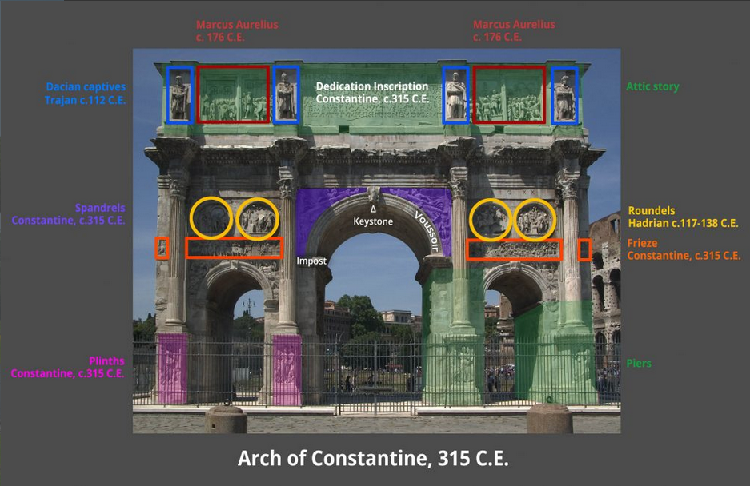
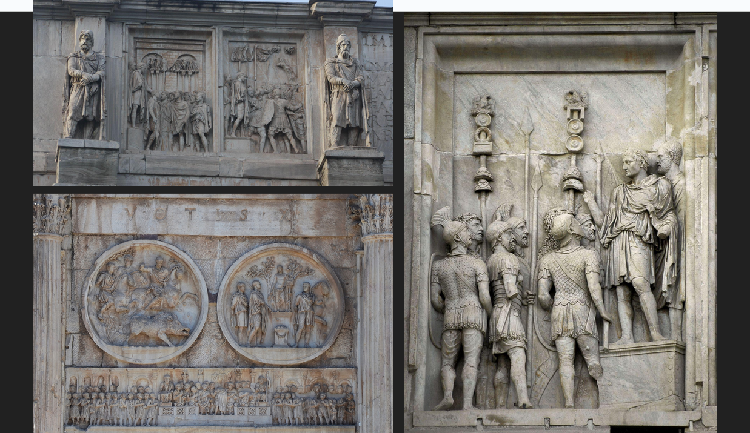
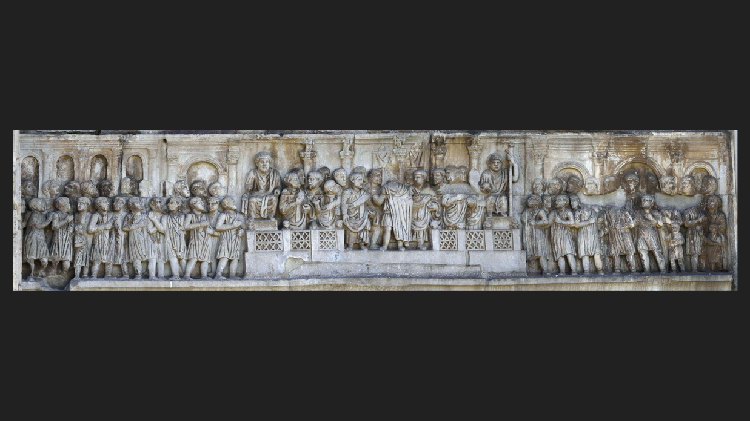
Caution is in order here. Aside from the dedicatory inscription on the monument itself, we lack narrative sources that might help explain what the arch meant to contemporary viewers.[19] Nevertheless the monument has impressed modern classicists, archaeologists, and historians as a thoughtful, unified whole. As an embodied statement of political propaganda, the monument’s program associates Constantine with three earlier rulers who were known for their strength, moderation, and benevolence. Such an association might have been a welcome source of support for Constantine’s claim to legitimacy, since he came from a non-aristocratic provincial family, and his mother was said to have been an innkeeper.[20] The monument clearly links the victorious Constantine with the three emperors who personified the imperial prosperity and tranquility of the golden age of the 2nd century. As for the aesthetic program of the arch, the conspicuous re-use of material and images from the 2nd century exhibited a taste for the traditional and archaic that was characteristic of other Constantinian building projects. A new aesthetics that mixed and alternated the traditional architectural orders and placed diverse materials in a variety first appeared in luxury buildings such as Constantine’s Lateran basilica in Rome and quickly spread elsewhere. The extensive use of spolia and the cultivation of varietas became commonplace in the later empire. Constantine preserved antiquities by investing them with a meaning their makers had not foreseen, and he did so with a “new aesthetic which lent spolia a conservative ideological content.”[21]
5. Reuse with Negative Attitude to Original: Memory of Absence
Let me turn now to efforts to forget someone which involve inflicting physical damage on an image or monument of that person. Very often these efforts seem merely formal or ritualized, and not really aimed at forgetting at all. This type of memory sanction depended upon the collective psychology of disgrace, and the possibility of using the remembered forgotten for ideological reasons. Iconoclastic acts such as harming images and monuments often play a part in a dialectics of memory, in which material objects themselves have a role as embodied signifiers.
Romans were aware of the gestures of dishonor that were heaped upon the public images of those who were outlawed or had otherwise fallen into disgrace. In many cases, this involved simply altering an existing statue. Writing in about 400 AD, Saint Jerome mentioned the defacement of the monuments of disgraced public figures as a routine occurrence. He wrote:
“When a tyrant is destroyed, his portraits and statues are also deposed. The face is exchanged, or the head removed, and the likeness of he who has conquered is superimposed. Only the body remains and another head is exchanged for those that have been severed.”[22]
In more extreme cases, an entire statue or image might be effaced. An infamous case in point is the Severan Tondo, which is a circular wooden panel about 13 inches across painted before the year 205 AD. We think it was made in Egypt and is likely to have been an image displayed in the office of a senior imperial official. When it was first made, the image showed the emperor, Septimius Severus, and his wife, Julia Domna, and their two sons, the future emperors Geta and Caracalla.[23] Geta’s face was subsequently scratched off, rubbed away, and smeared with filth. The reason for this damage to the image was Geta’s sudden fall from power after quarrelling with his brother less than a year after the death of Septimius Severus. On 19 December 211 AD at the order of Caracalla, Geta was murdered while in the arms of their mother. There followed a bloody purge of Geta’s supporters, as well as a posthumous accusation of treason against Geta, whose honors were stripped, and his statues and images attacked. Whatever subtle hint of dysfunctional family relations we might perceive in this episode, the violence done to Geta’s image is not an example of relegation to oblivion. For one thing, the Tondo’s survival since antiquity suggests that even after it was altered the image continued to be displayed as an imperial icon. Furthermore, it is only Geta’s face that was erased; his shoulders and body are still represented, and even the gap his head occupied has NOT been disguised. The context of this conspicuous erasure in the imperial portrait would have reminded any contemporary viewer of the disgraced and eliminated Geta. Significant silences and erasures that were meant to be seen are common enough in the ancient evidence to show that damaging the images and monuments of the disgraced was not the same as forgetting them.
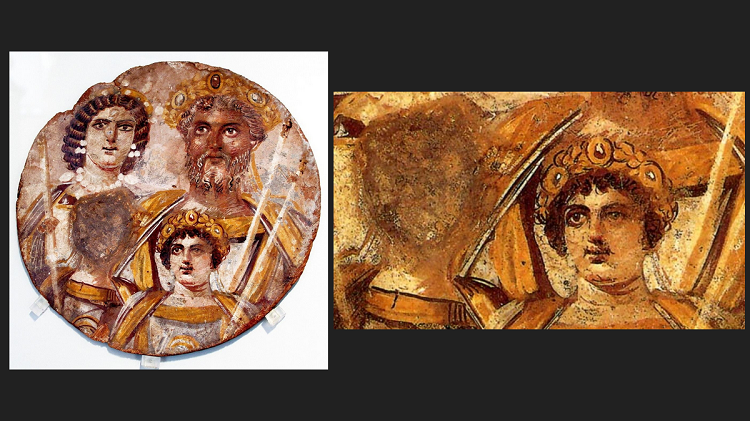
This case and many others like it show that some strictures against the proper treatment of the dead, denying the deceased burial and funeral monument, may paradoxically not result in the oblivion that Isidore of Seville apprehended, but may instead yield something more memorable than a physical monument. The obvious example of this within our program appears in the Antigone of Sophocles, in which Creon’s proclamation (lines 200-210; also lines 25-30) forbidding burial of the corpse of Polyneices explicitly aims at making the traitor not less but more memorable.
I can mention one other and perhaps less distressing example of this kind of non-erasure. This is a story about Constantine’s nephew, Emperor Julian, who ruled briefly from 361 to 363 AD, and it was told by the Christian historian Sozomen who wrote in the early 5th century AD. By that time, Julian was remembered as the emperor who had renounced his Christian faith, revived the pagan cults, encouraged the Jews to rebuild the Temple in Jerusalem, and had then been killed by an act of God while on an ill-advised Persian campaign. Sozomen reported that in the town of Caesarea Philippi, or Paneas, which is not far from the Sea of Galilee, Julian removed a famous statue of Jesus which was said to have been set up by the woman in the Gospel who had been healed of the flow of blood (Matthew 9:20-22) and replaced it with a statue of himself. In what Sozomen described as a sign of Christ’s power and divine anger, a lightning bolt broke the statue of Julian. As for the statue of Christ, although “pagans” smashed it, Christians later repaired it and placed it in a church where Sozomen affirmed it could still be seen, and where a previously unknown and wonderfully curative herb grew up at its base. Sozomen also described the damage done by lightning to the statue of Julian and said that the scorched fragments were preserved on the spot until his own time.[24] In other words, the blasphemous statue was destroyed, but in a spectacular way that simultaneously preserved physical evidence of the destruction.
6. Individuals and Oblivion: Creative Acts of Forgetting
These instances of conspicuous silences and erasures are all negative or destructive, since their intention was clearly prohibitory, interdictory, or discouraging. But conspicuous erasure could also be positive, creative, and constitutive when the one subject to erasure was transformed into material and invested with ideological meaning.
To see this, it helps first to recognize that the monument maker not only commemorates but always condenses and abbreviates as well. Monuments usually represent an ideal with which the monument maker anticipates viewers either will, or should, sympathize and identify. But the monument’s carrying capacity as a meaning-bearer is quite limited. It is an emblem or metonym of some larger set of beliefs or values. For this reason, the maker crafts the monument to capture some recognizable aspect or feature of the identity of an exemplary good or virtuous person, as this is recognized within a certain group or society, and at a certain time. Some of the most effective emblems of the approved identity incorporate elements of alien, or perhaps older repudiated identities. Through incorporation into the very fabric of the new emblem, the repudiated other brings into focus the approved and sanctioned identity.
I will provide two examples of what I mean, one simple, the other a bit more involved. The simple one comes from eighth-century Germany, in Hesse at a place called Geismar where the Anglo-Saxon missionary and ecclesiastical organizer named Boniface staged a spectacular event in about 722 AD. Finding a massive old oak tree, the Oak of Jove (or more likely Donar/Thor), which the local people worshipped, Boniface took an axe and dramatically felled the tree with his own hands before their eyes. He then used timber hewn from the sacred oak to erect a chapel dedicated to St. Peter at nearby Fritzlar. The offending object is destroyed, but also transformed into the material used to raise a new monument.[25]
My second example of the creative use of negation comes from the reign of the Spanish-born Christian emperor, Theodosius the Great, which lasted from 379 to 395 AD. At the outset, Theodosius governed only the eastern half of the empire, making his capital in Constantinople, while first Gratian and then his younger brother Valentinian II ruled the West. In 383 another Spanish soldier, Magnus Maximus, who had served in campaigns in Africa and Britain alongside the soldier father of Theodosius, was proclaimed western emperor by his army in Britain. This led to a confrontation in the West between Maximus and Gratian which left Gratian dead and Maximus in control of most of the West. In 387, when Maximus invaded Italy, the young Valentinian II appealed to his brother-in-law, Theodosius, for help. Theodosius defeated the forces of Maximus twice in battle before capturing and executing his foe in the northern Italian city of Ravenna.
Theodosius immediately initiated the routine sanctions against the memory and legacy of Magnus Maximus. His infant son, who was named Flavius Victor and whose father had unfortunately dubbed him Augustus, was killed. The name of Maximus was chiseled off inscriptions around the empire. In 388 and 389, Theodosian decrees overturned administrative appointments and legal judgments that had been made under the authority of Maximus. His senior supporters were executed, and their subordinates disgraced.
But simultaneous with these routine practices of erasure, in Rome Theodosius and his associates undertook an elaborate and costly campaign of memorializing Maximus. Theodosius made a formal visit to Rome and held a lavish triumphal ceremony during which Maximus’ severed head was paraded through the city, before being sent to Carthage where it remained on public display for at least the next twenty-five years.[26] (With the possible exception of the men of St. Serra’s, no one parties like the Romans.) The surviving panegyric speech, delivered by a professional orator on that occasion, extends to nearly 1300 lines, in which among other things, the orator celebrates the emperor’s triumph over “the tyrant”, “the purpled butcher”, “the man of death”, and “that man, formerly the most worthless little slave of your house and an attendant stationed at the tables of slaves”.[27] The panegyric presents the struggle as a war of liberation for Rome and the West, and informs us that western cities sent congratulations and offerings to Theodosius. Roman dignitaries set up commemorative statues of Theodosius, his son Arcadius, and Valentinian II, with inscribed bases dedicating them, “TO THE DESTROYER OF TYRANTS AND THE AUTHOR OF PUBLIC SECURITY, OUR LORD THEODOSIUS, CONSTANT AND FORTUNATE AUGUSTUS….”[28] Even before his death, the citizens of Emona in northern Illyricum paraded an effigy of the dead Maximus while singing mock funeral laments (Pacatus 2.37-38). We are told by another source that the holy hermit John of Egypt who lived in the Nitrian desert and had the gift of prophecy foresaw the fall of Maximus.[29] While some anticipated his demise, others commemorated it. As late at the 6th century, in Rome the day of Maximus’ death was still observed as a public holiday (Procopius of Caesarea, De bellis 3.4.16).
Even if the intention of memory sanctions had been to erase his memory altogether, utter oblivion is perhaps impossible to achieve. But in Rome there was likely some political value for Theodosius in commemorating the forgotten one. As a justification for the extension of Theodosian authority to Italy and the West, it likely helped to have a recent memory of the now liquidated dangerous rival who had held power in the West.
It is less clear that the memory of Maximus should have lived on in the East, which had not been his territory and had not been the scene of battle between him and Theodosius. Yet there too, and especially in Constantinople, Theodosius memorialized the forgotten one, and even transformed the image of Maximus to suit the imperial ideology of the Theodosian dynasty. Traces of this exist both in the huge spiral column Theodosius erected there which resembled Trajan’s column in Rome[30], and in the colossal triumphal arch, called the Golden Gate, which Theodosius built outside the city, and which evoked its Constantinian counterpart in Rome.[31]
Let me indicate how Maximus became a part of Theodosius’ monumental program in Constantinople through the obelisk that he set up on the center dividing barrier, again called the spina, in the Hippodrome. This obelisk had been carved from a solid block of granite and raised at the Temple of Karnak in Luxor, Upper Egypt. It was one of a pair that Emperor Constantine had removed from Luxor for his own building projects but which got no farther than Alexandria, apparently because it was so difficult to transport them.[32] Although Constantine’s successors Constantius and Apostate Julian both hoped to bring them to Constantinople, it was not until 390 AD in the reign of Theodosius that one of the two was set up there, and even then with difficulty. At some point the obelisk was broken (as you can tell from the hieroglyphic script that clearly extends lower on the obelisk than what is now visible), and what stands in Istanbul now, about 84 feet high including the base, is roughly 2/3 the size of the original. The base of the obelisk was probably carved in place and was completed no later than 392. It includes low relief sculptures of the emperor and his sons flanked by other dignitaries on all four faces; there are musicians, soldiers, and humbled barbarians on two faces. In one relief, the victorious emperor is served by the conquered; in another he holds forth the crown of victory to the winner of the race. There are two inscriptions, one in Greek, the language of daily life in Constantinople, and one in Latin, the language used in the imperial administration, army, and courts of law.
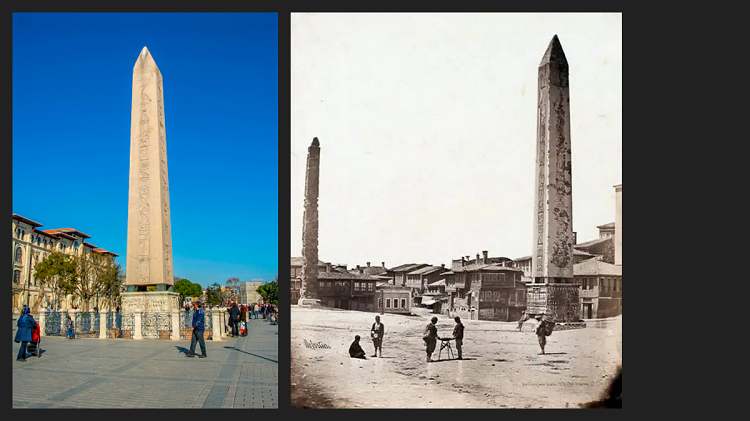
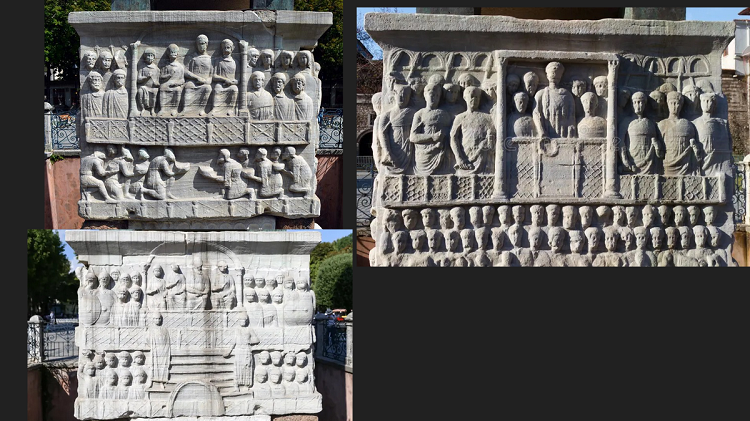
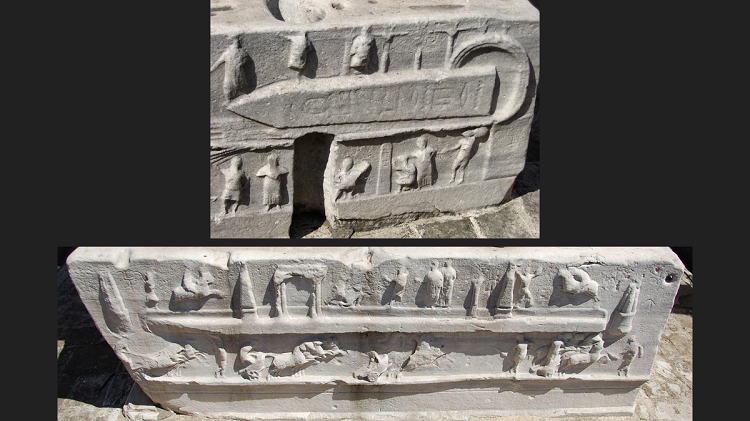
Addressing the reader in the first person, the Latin inscription proclaims the triumph of Theodosius: I WAS FORMERLY RELUCTANT TO OBEY THE SERENE MASTERS, EVEN WHEN ORDERED TO PROCLAIM THE VICTORY OVER THE EXTINCT TYRANTS, [BUT SINCE] ALL THINGS YIELD TO THEODOSIUS AND HIS EVERLASTING OFFSPRING, I WAS CONQUERED AND SUBDUED IN THREE TIMES TEN DAYS AND RAISED TO HIGH HEAVEN ON THE ADVICE OF PROCLUS.[33]
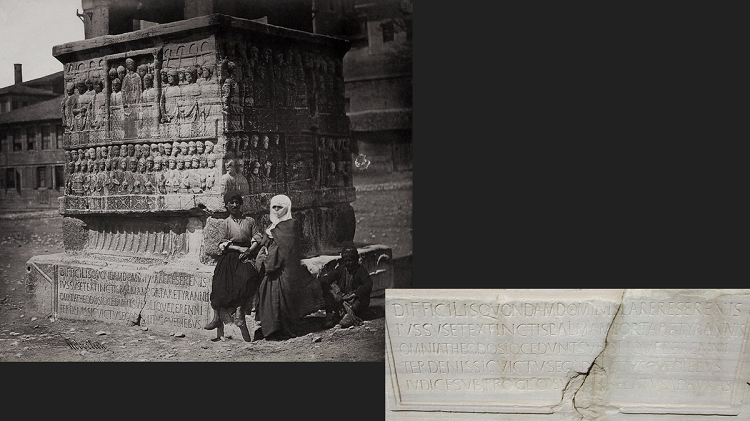
The “extinct tyrants” mentioned here can only refer to Maximus and his son. Although Theodosius overcame and slew another usurper, Eugenius, that was in 394, after the production of the inscription on the obelisk base. The reference to plural tyrants here shows that the practice of sanctioning memory must be understood not simply in negative terms as a process of memory suppression, but as a more creative process of image formation. Since the time of Constantine, the word “tyrant” was the standard way of referring to an enemy emperor defeated in civil war; but it also retained the moral force that it had long possessed, designating an enemy of rational political order, one who is a slave to vice and depravity, an unreliable friend, one prone to commit acts of violence on a whim.[34] Maximus was now transformed from an individual with a name and a particular story into an anonymous, generic tyrant; and his son, though an infant, was also retrospectively rendered nameless and raised to the level of tyrant alongside his father. Both were removed from their historical context and now, as caricatures, integrated into the ideological program of the Hippodrome. As one scholar puts it: “This was not remembering to forget, but creating a politically utile [useful] memory under the guise of interdiction.”[35]
The Theodosian program materialized at an important moment in the longer history of the Hippodrome, which had been begun in the second century and was then decorated and enhanced with monuments and treasures taken from around the empire under the Constantinian and Theodosian dynasties. The Hippodrome collection remained largely intact until the troops of the Fourth Crusade sacked the city in 1204 and melted down or hauled away most of the objects, including the ancient quadriga that now adorns the basilica San Marco in Venice (which 1797-1815 was in Paris, thanks to Napoleon). (Perhaps this embarrassing episode could have been avoided if the associate dean of that Crusade had been our Mr. Cooper.) Many of the monuments and statues were displayed on the spina, which bisected the racetrack along its central axis. There were statues of athletes, statues of gods, statues of animals, and statues of historical figures, such as Augustus, Diocletian, and Julius Caesar. There were quadrigas and other victory offerings, including the Serpentine Column which still survives in place. Herodotus (9.81) mentioned this tripod as an offering the Greeks made to the god Apollo at the shrine of Delphi in thanks for their recent victory over the army of Mardonius, the lieutenant of Xerxes, at nearby Plataea in 479 BC. The golden tripod is long gone, but the bronze intertwined bodies of the three serpents which held up the vessel are still inscribed with the words THESE FOUGHT IN THE WAR, followed by a list of the names of the thirty-one Greek cities that had joined the coalition against the Persian king. Nearly 800 years later, Constantine brought the tripod from Delphi and added it to his collection in the Hippodrome. [36] (It may have survived the Crusaders because it was adapted for use as one of the water features. [37]) Another statue, this one taken from near the site of the battle of Actium, had been a votive offering commemorating the victory in 31 BC of Octavian/Augustus over Cleopatra and Marc Antony, who had been vilified as a would-be Xerxes. It is also worth mentioning statues of a she-wolf and of a sow with piglets, which evoked the epic past as it had been represented in the Aeneid; their presence in the Hippodrome seems to claim a role for Constantinople in the prophetic future Virgil had imagined for Rome. Although now generic, because of their removal from the contexts their makers had intended, these emblems of victory and heritage lend grandeur and antiquity to the newest imperial capital.
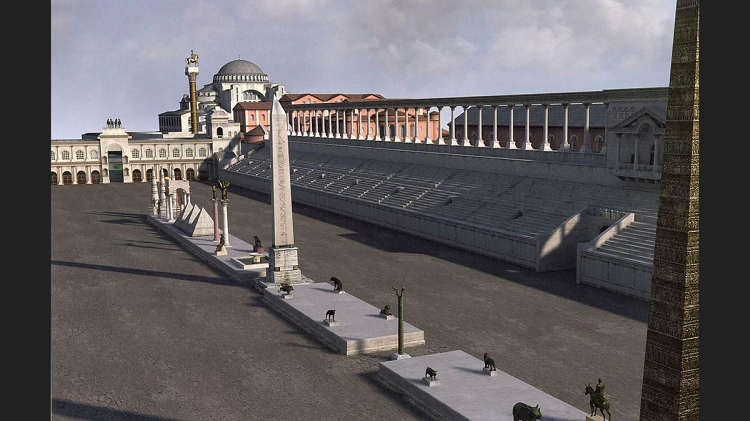
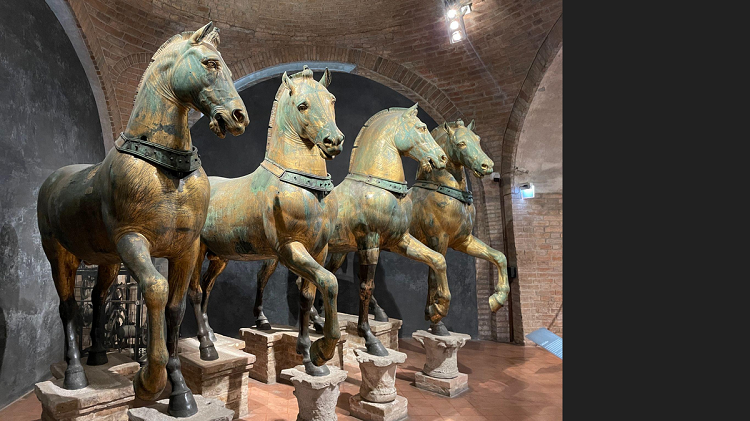
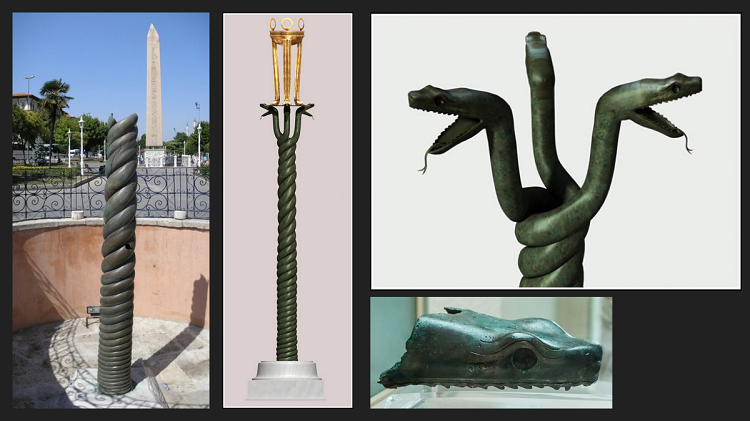
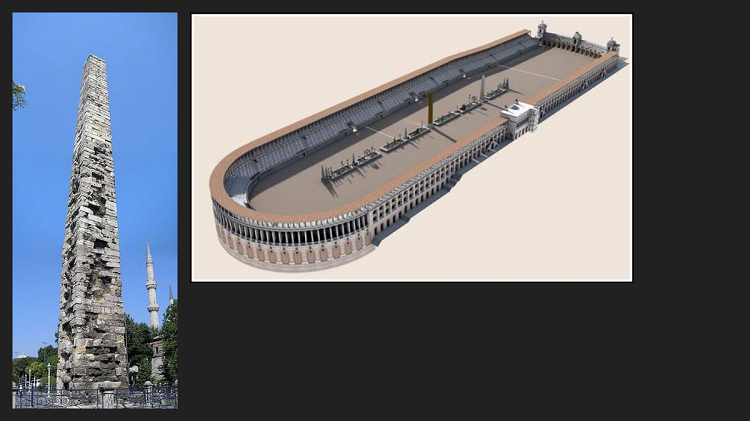
Theodosius’s obelisk dwarfed the memorials to Actium and Plataea, and at 84 feet tall it was nearly the highest monument on the spina, second only to a faux obelisk that had been built in place earlier that century and which is 105 feet tall. Constantine had tried but failed to bring the Egyptian obelisk to the city. Theodosius’ success at this meant that now the Hippodrome, like the Circus Maximus in Rome, had two obelisks, a status that placed Constantinople on an even footing with Rome and distinguished their circuses from all the other circuses of the empire.
Prestige of this sort mattered because the Hippodrome was not only a public sporting facility, but the premier social venue and political stage in the empire. The stadium provided seating for nearly 100,000 people, and already in the later 4th century was divided into sections that were regularly occupied by several different fan clubs or cheering factions. Though themselves in some ways rather like modern European and Latin American associations of football hooligans, these circus factions exercised a disproportionate influence upon the monarch, his family, and his ministers. In the autocratic political environment of the later empire, the ruler could not ignore the mood and the will of the people as expressed in thunderous chanting, in roaring demonstrations, and sometimes in deadly riots. In the 6th century, unrest among the circus factions would have toppled the Emperor Justinian, if his tough-as-nails empress, Theodora, had not braced him up. The so-called Nika Riots lasted for a bloody week during which nearly half the city was destroyed, including the old church of Hagia Sophia – which Justinian eventually replaced with what is the world’s most splendid church. (You can read this story in the pages of Edward Gibbon.)[38] In other words, what happened in the Hippodrome usually did not stay in the Hippodrome.
The monuments and statues displayed there were designed to impress, delight, and awe the citizens and visitors who attended the games. It would be reductive to suggest that such a rich and eclectic program had a single meaning. Yet the elements of it that I have pointed out suggest that one objective of its makers was to influence and guide what we now call the collective imagination or the social imaginary.[39] By this I mean the common understanding that makes possible shared practices and a widely shared sense of legitimacy, which are essential for the coherence of any society. The Constantinian and Theodosian monuments of the Hippodrome draw upon familiar stories, images, symbols, and myths to reassure spectators that the new city is a continuation of the old Rome; and that its current emperor enjoys victory and good rule, as had the ancient founders of Rome, as had the “good” emperors of the 2nd century. Looking backward the traditional culture moves forward. This process involved transforming historical figures such as Maximus and his son into generically recognizable types. Triumphant over tyrants in the wider Roman oecumene, in the little oecumene of the Hippodrome, a microcosm that embraced all ranks and orders of Roman citizens, Theodosius and his sons preside over the contest, and crown the triumphant athletes.[40] Evoking the comforting past, and the hierarchical order of the cosmos was a way of offsetting the novelty of the present situation, and of taming in advance the uncertainties of the future, which the sons of Theodosius would, presumably, hopefully, make tractable.
The hopes and aspirations of monument builders are one thing; another is foreknowledge divinely given. In the Nitrian desert, the holy hermit John of Egypt, burdened with the gift of prophecy, foresaw that soon after vanquishing another western pretender to the throne-- namely the tyrant Eugenius-- Theodosius himself would perish. In September 394 Eugenius was defeated and executed.[41] The following January Theodosius succumbed to disease in Milan. In the eulogy he declaimed at the funeral, Bishop Ambrose mentioned neither Hippodrome nor obelisk, but instead compared the deceased emperor to the Old Testament King Josiah, who had closed sacrilegious temples and smashed idols.[42] As it turned out, the sons of Theodosius did not fare well as rulers. In the East, Arcadius was dominated by his lieutenants and his wife until he died in 408. In the West, hobbled by intrigue and mistrust, Stilicho, the strong-man regent of young Honorius, could not prevent armed German tribes from crossing the frontier into Roman territory in 405. Stilicho was eventually encompassed and murdered by his rivals in the imperial court, leaving Honorius helpless to defend Italy against invaders. In 410, after a bitter siege, the army of the Visigothic warlord Alaric captured and sacked the eternal city.
Viewing these events from North Africa, the bishop of Hippo Regius reflected soberly on the character and limits of the loyalty that strangers and pilgrims in this life might have to any earthly empire, even one governed by a Christian monarch. The book containing those reflections, The City of God (5.26), mentions Theodosius not as a monument builder but as the righteous adversary of the now superseded pagan cults. During his reign, temples such as the famous Serapeum in Alexandria were closed, their idols melted down, their images pulverized. Thanks to Ambrose and Augustine, medieval people remembered Theodosius not as builder of monuments but as monument destroyer.[43]
[1] Isidore, Etymologiarum 15 DE AEDIFICIIS ET AGRIS, PL 82, 552:
“CAPUT XI De sepulcris.
1. Sepulcrum a sepulto dictum. Prius autem quisque in domo sua sepeliebatur. Postea vetitum est legibus, ne fetore ipso corpora viventium contacta inficerentur, Monumentum ideo nuncupatur, eo quod mentem moneat ad defuncti memoriam. Cum 82.0552A | enim non videris monumentum, illud est quod scriptum est: ‘Excidit tanquam mortuus a corde.’ [Psalms 31.12, in Psalterium Romanum] Cum autem videris, monet mentem, et ad memoriam te reducit, ut mortuum recorderis. Monumenta itaque et memoriae pro mentis admonitione dictae.” See also Augustine, De cura pro mortuis gerenda 6, ed., Joseph Zycha, CSEL 41 (Vienna, 1900), 630-631: “sed non ob aliud uel 'memoriae' uel monumenta dicuntur ea quae insignite fiunt sepulcra mortuorum, nisi quia eos, qui uiuentium oculis morte subtracti sunt, ne obliuione etiam cordibus subtrahantur, in memoriam reuocant et admonendo faciunt cogitari. nam et ‘memoriae’ nomen id apertissime ostendit et ‘monumentum’ eo quod moneat mentem, id est admoneat, nuncupatur. propter quod et Graeci μνήμεῑον uocant, quod nos memoriam seu monumentum appellamus, quoniam lingua eorum memoria ipsa, qua meminimus, μνήμη dicitur. cum itaque recolit animus, ubi sepultum sit carissimi corpus, et occurrit locus nomine martyris uenerabilis, eidem martyri animam dilectam commendat recordantis et precantis affectus. qui cum defunctis a fidelibus carissimis exhibetur, eum prodesse non dubium est his, qui [page 631] cum in corpore uiuerent, talia sibi post hanc uitam prodesse meruerunt.” For a ninth-century instance of interring the remains of the unknown dead in an unmarked grave so as to discourage the veneration of the remains of what were suspected to be pseudo-saints, see Amulo Lyons, Epistola 1.3, ed., Ernst Dümmler, MGH, EKA 3 (Berlin, 1899), 364: “Igitur, ut ad haec omnia, prout Christus donare dignatur, breviter respondeamus, et causae ambiguum cum vestra pariter dilectione resecemus, videtur nobis in primis ut ossa illa, quae nulla ratione, nulla auctoritate, nescio cujus sancti esse dicuntur, unde primum prurigo hujus curiositatis exorta esse videtur, omnino de sacris adytis et de loco celebri tollantur et nequaquam intra ecclesiam, sed foris in atrio, aut certe sub pariete, vel circa ipsam, vel quod utilius existimamus, circa aliam secreto in loco, apto et mundo, sub paucorum conscientia sepeliantur; ut quoniam et sancta esse dicuntur, aliquid eis reverentiae referatur, et quia esse penitus nesciuntur, nequaquam rudibus populis occasio erroris et superstitionis exsistant.”
[2] Isidore, Differentiae 522, PL 83, 62C: “Inter Sepulcrum et monumentum. Sepulcrum tantummodo tumulus defunctorum est, monumentum vero, nunc sepulcrum, nunc historia rerum gestarum: dictum eo quod mentem moneat, vel ad memoriam defuncti, vel ad recordationem rei scriptae.
[3] Four of many examples of figurative monuments, Maximus Taurinensis, Tractatus contra paganos 4, PL 57, col. 783C: “Quantum vero preces vel orationes fidelium valeant, sacra omnium divinorum voluminum monumenta loquuntur, et volentibus noscere facilis aditus conceditur ad salutem”; Aldhelm, De virginitate 392, ed. Rudolf Ehwald MGH, AA 15 (Berlin, 1919) 355: “veterum monumenta librorum”; Pablo Alvaro, Epistola XVIII.9, ed., Juan Gil, Scriptores Muzarabici saeculi VIII-XI, Vol. 1, CCCM LXVA (Turnhout, 2020), p. 561: “Verum quid mici opus est in re tam aperta diu consistere, que non unius uoluminis, set multorum monumenta uoluminum deuet continere? Illut sane breuiter intimem, quia si totius legis storiam accerrime uolueris, aut trinum Deum credeuis aut idolatrie errore multos et plures induces”; Jonas of Orléans, De cultu imaginum, Praefatio, PL 106, col. 307B: “quaedam monumenta librorum”.
[4] Historia. Empiricism and Erudition in Early Modern Europe, eds., Gianna Pomata and Nancy G. Siraisi (Cambridge, MA, 2005), Introduction, pp. 1-38.
[5] Regazzoni, Lisa, “Unintentional Monuments, or the Materializing of an Open Past,” History and Theory 61 (2022), 242-268, at 246-247; https://doi.org/10.1111/hith.12259
Regazzoni, Lisa, “Stones and Other Stuff,” in “One More Thing” (History and Theory website: https://historyandtheory.org/omt/2022-regazzoni). On remains as the proper object of antiquarianism, see Willem Drijvers, Lorenzo Focanti, Raf Praet, and Peter Van Nuffelen, “Theorising Antiquarianism: Momigliano and his Successors,” which is the Introduction to Mapping Antiquarianism in Late Antiquity, a special issue of Revue Belge de philologie et d’histoire 96 (2018), 913-924.
[6] SENATVS POPVLVSQVE ROMANVS / IMP CAESARI DIVI NERVAE F NERVAE / TRAIANO AVG GERM DACICO PONTIF / MAXIMO TRIB POT XVII IMP VI COS VI PP / AD DECLARANDVM QVANTAE ALTITVDINIS / MONS ET LOCVS TAN[tis oper]IBVS SIT EGESTVS
(ILS 294 = CIL 6.960)
Expanded version:
SENATVS POPVLVSQVE ROMANVS / IMPeratori CAESARI DIVI NERVAE Filio NERVAE / TRAIANO AVGusto GERManico DACICO PONTIFici / MAXIMO TRIBunicia POTestate XVII IMPeratori VI COnSuli VI Patri Patriae / AD DECLARANDVM QVANTAE ALTITVDINIS / MONS ET LOCVS TAN[tis oper]IBVS SIT EGESTVS
Translation:
A. The Senate and the People of Rome to the Emperor, Caesar Nerva, son of the deified Nerva, Traianus Augustus, Germanicus, Dacicus, Pontifex Maximus, invested with the power of the tribune seventeen times, hailed imperator six times, elected consul six times, father of the fatherland, to demonstrate how lofty a hill and (what area of) ground was carried away for these mighty works. (based on D. R. Dudley, Urbs Roma. 1967: Aberdeen).
B. (last line): . . . to declare how high as hill and place have been excavated for these works (Smallwood 1966: 128; Rossi 1971: 49).
C. (last line): . . . to show the height and location of the hill removed for such great structures ( Aicher 2004: 212).
D (last line): “. . . in order to make visible (that is, from the summit of the column . . .) how much in elevation the hill (slope of the Quirinal) and the site (of the Forum Ulpium) had been raised up by such noble works of art” (G. Boni 1907a: 6). Boni explains; “tantis operibus I took to refer not to the manual labour of slaves, but to the architectural works by which Apollodorus or his predecessors of the Flavian epoch had ennobled and beautified both the mons and the locus (loc. cit 6).
[7] This dual character of Monuments as in some ways both intentional and unintentional, deliberate and naïve, influenced the thinking and usage of many authors in the 18th and early 19th centuries, including at least one whose work we read in the program, namely Alexis de Tocqueville. De Tocqueville is a good example of an author who refers both to intentional and unintentional monuments. The context usually points to which sort of monument he means. For the unintentional sort, Alexis de Tocqueville, Democracy in America Vol. 1, Part 1, chapter 1, p. 26: “The Indians of our day cannot give any information about the history of that unknown people […] Traditions, those perishable and constantly re-emergent monuments of a primitive world, furnish no light.” Also unintentional, Democracy in America, Vol. 1, Part 1, chapter 2, translated by Harvey Mansfield and Delba Winthrop (Chicago, 2000), p. 28: “If it were possible for us to go back to the elements of societies and to examine the first monuments of their history, I do not doubt that we could discover in them the first cause of prejudices, habits, dominant passions, of all that finally composes what is called national character”. Or again unintentional, Democracy in America Vol. 1, Part 2, chapter 7, p. 239: “And alongside the prison, lasting monument to the mildness and the enlightenment of our time, was a dungeon that recalled the barbarism of the Middle Ages.” But Democracy in America Vol. 2, Part 1, chapter 12, p. 443, seems to feature a contrast between unconscious or semi-conscious “monuments of the arts” which are “more numerous and less grand” in democratic centuries, and the intentional, deliberate “public monuments” of the democratic Americans which are gigantic. Mixed use, Democracy in America Vol. 2, Part 2, chapter 5, p. 198: “The only historical monuments of the United States are newspapers.” Other examples from the same work could be adduced.
[8] Brian A. Curran, Anthony Grafton, Pamela O. Long, and Benjamin Weiss, Obelisk:
A History (Boston, 2009).
[9] Paul Zanker, The Power of Images in the Age of Augustus (Michigan, 1988), 144 on the solarium obelisk used as gnomon on sundial, the inscription refers to the victory over Egypt 20 years earlier and includes a dedication to the Sun god Sol.
[10] Frances Foster, “Bees and Vultures: Egyptian Hieroglyphs in Ammianus Marcellinus,” The Classical Quarterly, 70(2) (2020), 884-890. doi:10.1017/S0009838820000865. H. Te Velde, “Egyptian Hieroglyphs as Signs, Symbols and Gods,” in Visible Religion IV-V, Approaches to Iconology (1985-86), 63-72.
[11] Suidae Lexicon Μ405, Suidae Lexicon Pars III, ed. Ada Adler, Teubner (Stuttgart 1994; reprint of 1933 edition), 346; paraphrased by Edward Gibbon, The History of the Decline and Fall of the Roman Empire XXXV, ed. and abridged by David Womersley (New York, 2000), 416.
[12] Jaś Elsner, “Iconoclasm and the Preservation of Memory,” in Robert S. Nelson and Margaret Olin, eds., Monuments and Memory, Made and Unmade (Chicago, 2003), 209-231, at 211: so routine was such public commemoration that there was something “performative” or even “ritualized” about it, as a “process of embodied remembering.”
[13] Cornelii Taciti Annalium 3.70, ed., C.D. Fisher (Oxford, 1985; reprint of 1906 ed.), 128-129: “ L. Ennium equitem Romanum, maiestatis postulatum quod effigiem principis promiscum ad usum argenti vertisset, recipi Caesar inter reos vetuit, palam aspernante Ateio Capitone quasi per libertatem. non enim debere eripi patribus vim statuendi neque tantum maleficium impune habendum. sane lentus in suo dolore esset: rei publicae iniurias ne largiretur. intellexit haec Tiberius, ut erant magis quam ut dicebantur, perstititque intercedere. Capito insignitior infamia fuit quod humani divinique iuris sciens egregium publicum et bonas domi artes dehonestavisset.” This prompted open protest, in what looked like a gesture of independence, from Ateius Capito. The Senate should not be stripped of its power to decide cases, he said, and a crime of such magnitude should not go unpunished—by all means let the emperor be slow to anger when personally hurt, but he should not condone injury done to the state! Tiberius took this for what it was, not for what was actually being said, and maintained his veto. Capito’s debasement was all the more marked because, an expert in secular and religious law as he was, he was thought to have dishonored a fine public career and his own personal qualities.
[14] In the last decades of the 4th century, for example, Bishop Ambrose of Milan referred in passing to this very idea as though it was a routine fact of daily life. Ambrosius Mediolanensis, Expositio Psalmi CXVIII, Sermo 10.25 § 4, ed. Michael Petschenig, CSEL 62 (Vienna, 1913), p. 219: “Qui enim coronat imaginem imperatoris, utique illum honorat cuius imaginem coronauit, et qui statuam contempserit imperatoris, imperatori utique cuius statuam consputauerit fecisse uidetur iniuriam. Gentiles lignum adorant, quia Dei imaginem putant: sed invisibilis Dei imago, non in eo est quod videtur: sed in eo utique quod non videtur.”
[15] Severian of Gabala, On the Creation of the World 5.5, as qtd. in J. Elsner, Imperial Rome and Christian Triumph, p. 54; PG 56, col. 489. Severian was bishop of Gabala in Syria but visited Constantinople for long enough to preach homilies there, some of which have been preserved. He died after 408 AD. Johannes Quasten, Patrology, Vol. 3 (1950; reprinted Westminster, Maryland 1992), 484-486.
[16] On imperial legislation that discouraged the spoliation of urban buildings, see Karl Leo Noethlichs, “Kaiserzeitliche und spätantike staatliche Regularien zur Spoliierung – ein Kommentar, “ in Stefan Altekamp, Carmen Marcks-Jacobs, and Peter Seiler, eds., Perspektiven der Spolienforschung 1: Spoliierung und Transposition. Berlin, Boston , 2013, 11-22; Joseph Alchermes, “Spolia in Roman Cities of the Late Empire: Legislative Rationales and Architectural Reuse,” Dumbarton Oaks Papers 48 (1994), 167-178.
[17] Ine Jacobs, “Old statues, new meanings: Literary, epigraphic and archaeological evidence for Christian reidentification of statuary,” Byzantinische Zeitschrift 113/3 (2020), 789-836. 791, no. 5, distinguishes reidentification, in which an entirely new identity was assigned to a statute, from reinterpretation, in which the impact and interpretation of a certain motif or element shifted but was not entirely changed; The Afterlife of Greek and Roman Sculpture: Late Antique Responses and Practices, eds. Troels Myrup Kristensen and Lea Margaret Stirling (Ann Arbor, 2016), consider the whole spectrum of responses and practices to which ancient sculpture were exposed: production, reuse, recarving, use as building material, reduction to lime in firey kilns, simple destruction without reuse, mutilation.
[18] Jessica Hughes, “Memory and the Roman viewer: Looking at the Arch of Constantine” in Karl Galinsky (ed.) Memoria Romana: Memory in Rome and Rome in Memory, Supplement to the Memoirs of the American Academy at Rome (Rome, 2014), pp. 103-116; Beat Brenk, “Spolia from Constantine to Charlemagne: Aesthetics versus Ideology,” Dumbarton Oaks Papers 41 (1987), 103-109, at 104-105; H. P. L’Orange and A. von Gerkan, Der spätantike Bildschmuck der Konstaninsbogens 2 vols. (Berlin, 1939).
[19] Marina Prusac, “The Arch of Constantine: Continuity and Commemoration through Reuse” in Recycling Rome, eds. Turid Karlsen Seim and Marina Prusac (Roma: Scienze e lettere, 2012), 132: IMP(eratori) CAES(ari) FL(avio) CONSTANTINO MAXIMO | P(io) F(elicit) AUGUSTO S(enatus) P(opulus) Q(ue) R(omanus) | QUOD INSTINCTU DIVINITATIS MENTIS | MAGNITUDINE CUM EXERCITU SUO | TAM DE TYRANNO QUAM DE OMNI EIUS | FACTIONE UNO TEMPORE IUSTIS | REM PUBLICAM ULTUS EST ARMIS | ARCUM TRIUMPHIS INSIGNEM DICAVIT
For the Emperor Caesar Flavius Constantine the Greatest, pious blessed Augustus, because by inspiration of divinity, in greatness of his mind, from a tyrant on one side and from every faction of all on the other side at once, with his army he avenged the republic with just arms, the Senate and Roman People (SPQR) dedicated this arch as a sign for his triumphs.
[20] Jan Willem Drijvers, Helena Augusta. The Mother of Constantine the Great and the Legend of her Finding of the True Cross (Leiden, 1992), 15, of whose birth and origins contemporary sources were silent, perhaps because their insignificance might have damaged her son’s reputation. Later fourth-century sources represent her as an innkeeper or servant of an inn.
[21] Beat Brink, “Spolia from Constantine to Charlemagne: Aesthetics versus Ideology,” Dumbarton Oaks Papers 41 (1987), 103-109, at 109.
[22] Jerome, Commentaria in Abacuc 2.3.14-16, ed. M. Adriaen, ed., CCSL 76A (Turnhout, 1970), 644 (also PL 25. 1329B): “Ponamus exemplum, ut quod dicimus manifestius fiat, si quando tyrannus obtruncatur, imagines quoque eius deponuntur, et statuae, et uultu tantummodo commutato, ablatoque capite, eius qui vicerit, facies superponitur, ut manente corpore, capitibusque praecisis, caput aliud commutetur.”
[23] Adrastos Omissi, “Damnatio Memoriae or Creatio Memoriae? Memory Sanctions as Creative Processes in the Fourth Century AD,” The Cambridge Classical Journal 62 (2016), 170-199, at 172-173.
[24] Cassiodorus-Epiphanius, Het 6.41-42 (eds. Jacob and Hanslik, 363-4) relying on Sozomen, He 5.21.1-4 (ed. Hansen, 654-6) who mentioned Eusebius, He 7.18.2 (eds. Schwartz and Mommsen, 672); on the theurgic character of Julian’s own interest in statues see Maria Carmen De Vita, “Giuliano Imperatore e il culto delle immagini sacre: un esempio de ТЕХΝΗ ТЕΛЕΣΤΙΚΗ?,” in Statue, Rituali, Scienza e Magia dalla Tarda Antichità al Rinascimento, ed. Luigi Canetti (Florence, 2017), 67-85; Thomas Weber, “Die Statuengruppe Jesu und der Haimorrhoύsa in Caesarea-Philippi,” Damaszener Mitteilungen 9 (1996), 209-216; for a brief account of Paneas as destination for pilgrims, Pierre Maraval, Lieux saints et pèlerinages d’Orient. Histoire et géographie, des origins à la conquête arabe (Paris, 1985; reprint 2011), 334-335.
[25] Willibald, Vita Bonifatii 6 (ed. Wilhelm Levison, Vitae Sancti Bonifatii, Scriptores Rerum Germanicarum 57, MGH [Hannover, 1905], 31-32); John-Henry Clay, In the Shadow of Death: Saint Boniface and the Conversion of Hessia, 721-54, (Turnhout, 2010), 200-203 and 295-307; Gregory C. Bryda, "Tainted Trees: Uncovering the Long Shadow over Germany’s Medieval Maypoles and Ancient Tree Cults" Zeitschrift für Kunstgeschichte, vol. 85, no. 3, 2022, pp. 337-362. https://doi.org/10.1515/ZKG-2022-3004; for an example from the Ottonian period, Ittai Weinryb, “Hildesheim Avant-Garde: Bronze, Columns, and Colonialism,” Speculum 93 (2018): 728-782.
[26] Mark Humphries, “Emperors, Usurpers and the City of Rome: Performing Power from Diocletian to Theodosius,” in J. Wienand, ed., Contested Monarchy: Integrating the Roman Empire in the fourth century AD (Oxford, 2015) 151-168, at 160-161; on the decapitated head, Olympiodorus Fragment 19, DFHG - DIGITAL FRAGMENTA HISTORICORUM GRAECORUM Vol. 4, Book 9 (https://www.dfhg-project.org/DFHG/index.php?volume=Volumen%20quartum#). 25 years after the death of Maximus, his head was still hanging outside the imperial palace in Carthage.
19. Ἄρχεται δὲ ἡ δευτέρα ὧδε· ὅτι Ἰοβῖνος παρὰ γνώμην Ἀδαούλφου τὸν ἴδιον ἀδελφὸν Σεβαστιανὸν βασιλέα χειροτονήσας, εἰς ἔχθραν Ἀδαούλφῳ κατέστη. Καὶ πέμπει Ἀδάουλφος πρὸς Ὁνώριον πρέσβεις, ὑποσχόμενος τάς τε τῶν τυράννων κεφαλὰς καὶ εἰρήνην ἄγειν. Ὧν ὑποστρεψάντων, καὶ ὅρκων μεσιτευσάντων, Σεβαστιανοῦ μὲν πέμπεται τῷ βασιλεῖ ἡ κεφαλή· Ἰοβῖνος δὲ ὑπὸ Ἀδαούλφου πολιορκούμενος, ἑαυτὸν ἐκδίδωσι, καὶ πέμπεται κἀκεῖνος τῷ βασιλεῖ, ὃν αὐθεντήσας Δάρδσνος ὁ ἔπαρχος ἀναιρεῖ. Καὶ ἀποτίθενται ἄμφω αἱ κεφαλαὶ Καρθαγένης ἔξωθεν, ἔνθα καὶ ἡ Κωνσταντίνου καὶ ἡ Ἰουλιανοῦ ἀπετμήθησαν πρότερον, ἥ τε Μαξίμου καὶ ἡ Εὐγενίου, οἳ ἐπὶ Θεοδοσίου τοῦ μεγάλου τυραννίδι ἐπιθέμενοι, εἰς τοῦτο τέλους κατέστρεψαν.
[An. 413.] Alteram vero hinc auspicatur. Jovinus fratrem suum Sebastianum, invito Adaulpho, imperatorem creans, in ejus odium incurrit. Adaulphus itaque per internuntios, capita se tyrannorum missurum pacemque initurum, Honorio pollicetur. Hi domum ubi redierunt, et jusjurandum praestitum est, Sebastiani mox caput imperatori mittitur. Jovinus etiam ipse ab Adaulpho obsessus se dedidit, missusque ad imperatorem est: quem Dardanus praefectus sua manu percutiens interimit. Utriusque caput extra Carthaginem palis infixum: ubi et Constantini ac Juliani antea resectum, Maximi item et Eugenii, qui, sub Theodosio Magno tyrannidem affectantes, eundem sunt exitum sortiti.
[27] XII. Latini Pacati Drepanii panegyricus Theodosio Augusto dictus, in ed., Emil Baehrens, XII Panegyrici latini (Leipzig, 1874), 271-314, at 42.2-3; 24.1; 43.4; 31.1; Sophie Lunn-Rickliffe, “Commemorating the Usurper Magnus Maximus: Ekphrasis, Poetry, and History in Pacatus' Panegyric of Theodosius,” Journal of Late Antiquity 3 (2010), 316-336.
(https://archive.org/details/xiipanegyricila02baehgoog/page/n344/mode/1up)
[28] Omissi, “Damnatio Memoriae,” p. 177, no. 33, cites the CIL information.
[29] Historia Lausiaca, De Iohanne Lycopolitano 35.3, ed. Adelheid Wellhausen, Die lateinischen Übersetzung der Historia lausiaca des Palladius (Berlin, 2003), 603; Mark Sheridan, 'John of Lykopolis', in Gawdat Gabra, and Hany Takla (eds), Christianity and Monasticism in Middle Egypt (Cairo, 2015; online edn, Cairo Scholarship Online, 19 Jan. 2017), 123-132. https://doi.org/10.5743/cairo/9789774166631.003.0012, accessed 23 Dec. 2023.
[30] Omissi, “Damnatio Memoriae,” 186-190. In the center of the large forum that Theodosius had built about half a mile from Constantine’s forum, in the period 386-393, Theodosius raised a massive historical column echoing those of Trajan and Marcus Aurelius in Rome. Rome was in fact the only other city to have an historical column of this sort. On the eastern and western ends of the forum were triumphal arches upon which stood statues of Honorius and Arcadius, the sons of Theodosius. With a statue of Theodosius on its top, the column was decorated with a single spiral frieze depicting the military triumphs of Theodosius, including his conquest of the West and the fall of Maximus. Both Trajan and Theodosius were Spaniards, and Theodosius claimed descent from Trajan. The column was dismantled around 1500, but its surviving fragments and ancillary sources show how Theodosius drew upon the Roman past to affirm his victory and the prestige of Constantinople as the New Rome, and to project a future in the eastern and western empire dominated by his own dynasty.
[31] Omissi, “Damnatio Memoriae,” 190-194. Before Theodosius II constructed the large circuit wall encompassing Constantinople (parts of which are still standing today), Theodosius the Great erected a massive triumphal arch, called the Golden Gate, at the southern extremity of the eventual perimeter of the wall, straddling the Via Egnatia, which is the main route into the city from the west. The arch was constructed of white marble, and the inscription over the main portal once read: THEODOSIUS DECORATES THIS PLACE AFTER THE DEATH OF A TYRANT and HE WHO BUILDS THE GATE WITH GOLD RULES THE GOLDEN AGE. The Golden Gate evokes the arch of Constantine in Rome which had itself commemorated a victory in civil war against another adversary who had been labelled “tyrant”. We are not sure when the Golden Gate was constructed. But we know that Theodosius returned to Constantinople on 10 November 391, and there is a good possibility that he and his troops passed through this arch on their way into the city. Hubert Cancik, “Grösse und Kolosalität als religiose und Aesthetische Kategorien. Versuch einer Begriffsbestimmung am Beispiel von Statius, Silve I 1: Ecus Maximus Domitiani Imperatoris,” Visible Religion 7 Genres in Visual Representations (1990), 51-68.
[32] Henning Wrede, “Zur Errichtung des Theodosiusobelisken in Istanbul,” Istanbuler Mittelungen 16 (1966), 178-198.
[33] Omissi, “Damnatio Memoriae,” 179-180, who provides the CIL reference. The Greek inscription: ONLY EMPEROR THEODOSIUS DARED TO ERECT THE FOUR-SIDED COLUMN WHICH HAD LAIN HEAVY ON THE EARTH FOR A LONG TIME. PROCLUS WAS SUMMONED, AND THIS SO ENORMOUS COLUMN WAS PUT UP IN THIRTY-TWO SUNS. Linda Safran, “Points of View: The Theodosian Obelisk Base in Context,” in Greek, Roman, and Byzantine Studies 34 (1993), 410-435, at 410, who provides the CIG reference; Ulrike Ritzerfeld, "’Omnia Theodosio cedunt subolique perenni’. Überlegungen zu Bildprogramm und Bedeutung des Theodosiusobelisken und seiner Basen in Konstantinopel,” Jahrbuch für Antike und Christentum 44 (2001), 168-184.
[34] Timothy D. Barnes, “Oppressor, persecutor, usurper: the meaning of ‘tyrannus’ in the fourth century,” in G. Bonamente and M. Mayer, eds., Historiae Augustae Colloquium Barcinonense, (Bari, 1996), 55-65.
[35] Omissi, “Damnatio Memoriae,” 182.
[36] Thomas F. Madden, “The Serpent Column of Delphi in Constantinople: Placement, Purposes, and Mutilations,” Byzantine and Modern Greek Studies 16 (1992), 111-145, at 112, for the embarrassment of the ecclesiastical historians; in the early sixth century, the pagan historian Sozomenos, Historia ecclesiastica 2.5.4, eds., G.C. Hansen and J. Bidez (Turnhout, 2004), 218, knew that the serpent column was the votive offering commemorating Plataea.
[37] Madden, “The Serpent Column of Delphi,” 116-121.
[38] Alan Cameron, Circus Factions: Blues and Greens at Rome and Byzantium (Oxford, 1976).
[39] Charles Taylor, Modern Social Imaginaries (Durham, 2004), 23; more recently, Editorial Collective, “Social Imaginaries and the Imagination,” International Journal of Social Imaginaries 1 (2023), 3-16.
[40] On the Hippodrome as cosmos in miniature, Cameron, Circus Factions, 230-231; G. Dagron, Naissance d’une capitale. Constantinople et ses institutions de 330 à 451 (Paris, 1974), 330-338; M. Agnosini, “Rome in Constantinople: The Hippodrome in John Lydus’ De mensibus”, Revue belge de philologie et d’histoire 26 (2018), 925-945, esp. 931-941.
[41] Rufinus, Historia monachorum sive de vita sanctorum partum, De Iohanne 1. 7.12-13, ed., Eva Schulz-Flügel, (Berlin, 1990), 274: “Hoc tamen scire vos volo, quod hodierna die victoriae religiosi principis Theodosii Alexandriae nuntiatae sunt de Eugenio tyranno. Necesse est autem et ipsum Theodosium non multo post propria morte vitam finere. Cumque profecti ab eo fuissemus, haec ita gesta esse ad fidem conperimus, ut ipse praedixerat.”
[42] Funeral Oration on Emperor Theodosius 4 and 38, trans. Roy J. Deferrari, Fathers of the Church (New York, 1953), pages 309 and 324, that later with a comparison of Theodosius to King Josias, “who removed sacrilegious errors, closed temples, destroyed idols”.
[43] Graham Ward, “Lessons in leadership: Constantine and Theodosius in Frechulf of Lisieux’sHistories”, in Gantner C, McKitterick R, Meeder S, eds. The Resources of the Past in Early Medieval Europe. Cambridge: Cambridge University Press; 2015:68-84. doi:10.1017/CBO9781316134269.007. Friedrich Nietzsche, Zur Genealogie der Moral. Eine Streitschrift. Leipzig. Verlag von C. G. Neumann, 1887. Zweite Abhandlung 24: “Damit ein Heiligthum aufgerichtet werden kann, muss ein Heiligthum zerbrochen werden: das ist das Gesetz — man zeige mir den Fall, wo es nicht erfüllt ist!…” “In order to build a sanctuary [ein Heiligthum], a sanctuary must be shattered: that is the law—show me a case where it is not fulfilled!...” Friedrich Nietzsche, On the Genealogy of Morality trans. Carol Diethe, Cambridge 2006, 65-6: Second Essay 24: “ – I shall conclude with three question marks, that much is plain. ‘Is an ideal set up or destroyed here?’ you might ask me . . . But have you ever asked yourselves properly how costly the setting up of every ideal on earth
has been? How much reality always had to be vilified and misunderstood
in the process, how many lies had to be sanctified, how much conscience
had to be troubled, how much ‘god’ had to be sacrificed every time? If a [page 65-66] shrine is to be set up, a shrine has to be destroyed: that is the law – show me an example where this does not apply! . . .” Trans. Maudemarie Clark and Alan J. Swensen, Hackett 1998, second treatise 24, p. 65. “In order to build a sanctuary, a sanctuary must be shattered: that is the law—show me a case where it is not fulfilled!...”
| Receive lectures and talks via podcast! | ||||
|---|---|---|---|---|

